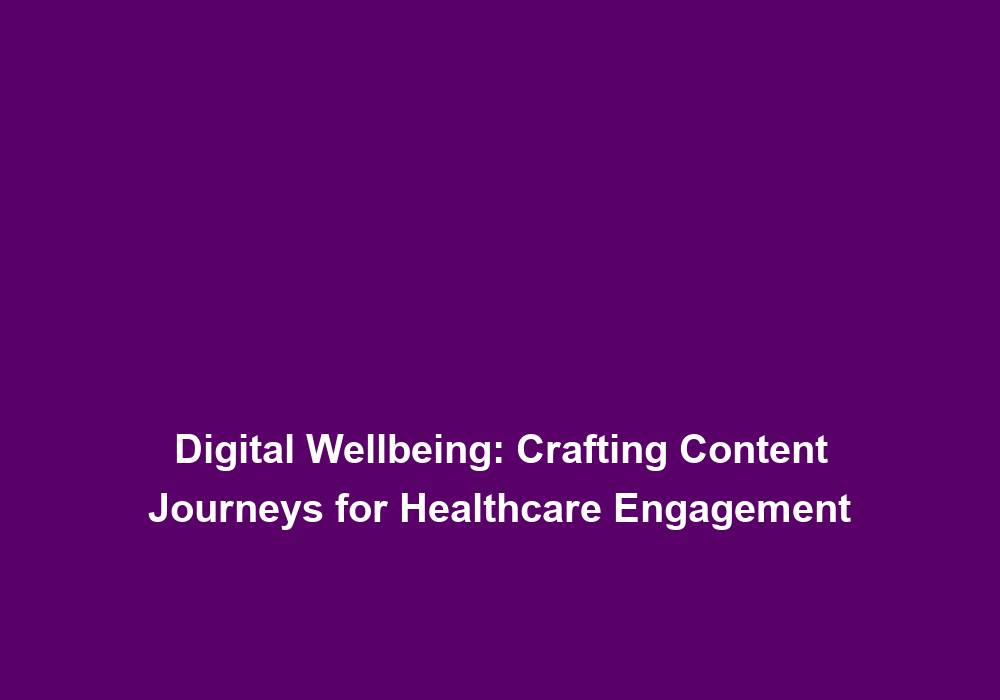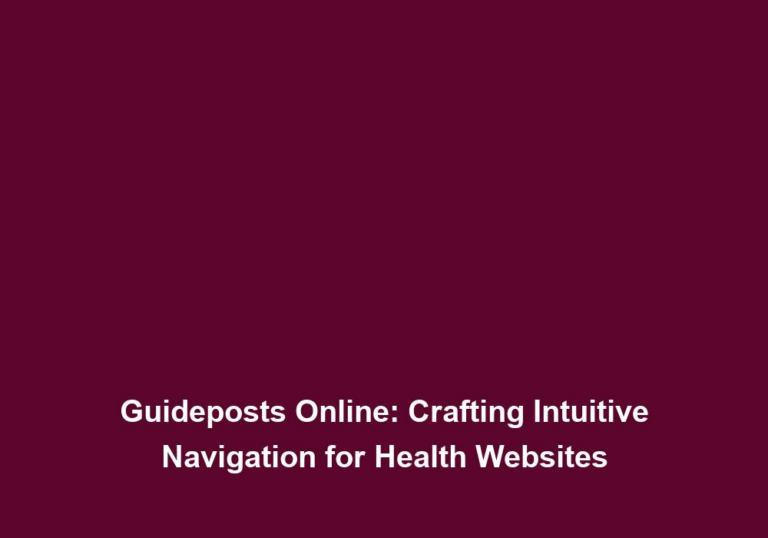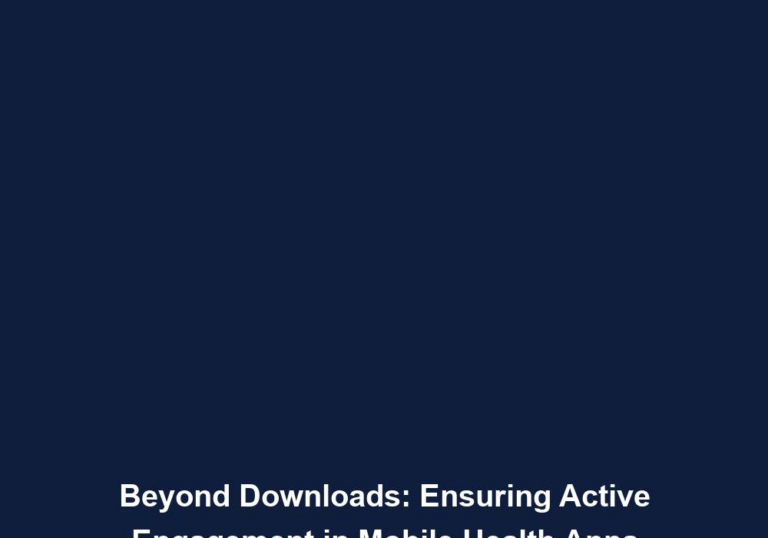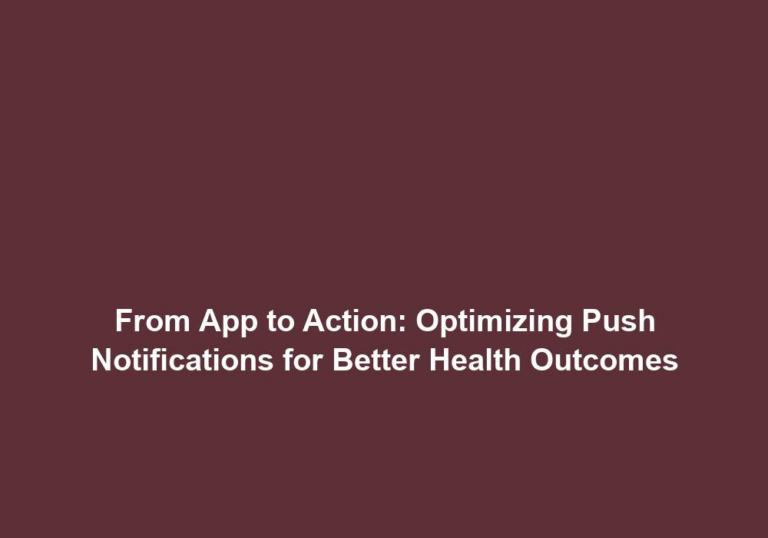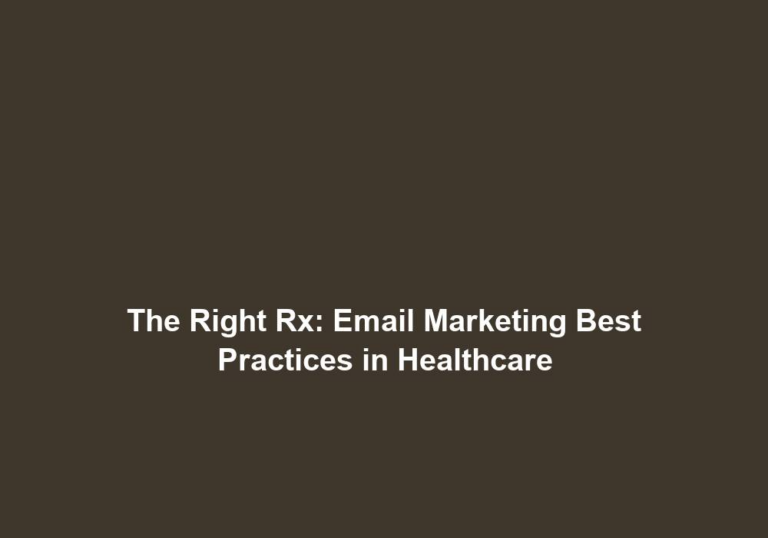Digital Wellbeing: Crafting Content Journeys for Healthcare Engagement
The digital age has revolutionized the way we access information, connect with others, and even manage our healthcare. With the rise of smartphones and other digital devices, people now have access to a wealth of health-related information at their fingertips. This has led to a significant shift in how healthcare providers engage with their patients and the need for crafting content journeys that promote digital wellbeing.
The Importance of Digital Wellbeing in Healthcare
Digital wellbeing refers to the conscious and intentional use of digital technology to enhance one’s physical, mental, and emotional health. In healthcare, it plays a crucial role in empowering patients to take control of their well-being and improve their overall quality of life. By leveraging digital tools and platforms, healthcare providers can deliver personalized and targeted content that educates, motivates, and supports patients throughout their healthcare journey.
Digital wellbeing is especially important in healthcare as it allows patients to access healthcare resources and information conveniently. With the constant advancements in technology, patients can now use their smartphones or other digital devices to monitor their health, access medical records, schedule appointments, and even connect with healthcare providers through telemedicine. This convenience and accessibility empower patients to actively participate in their own healthcare and make informed decisions.
Understanding Content Journeys
A content journey is a strategic approach to delivering information and resources to users at different stages of their healthcare journey. It involves creating a seamless and personalized experience that guides patients from awareness to action. Crafting effective content journeys requires understanding the user’s needs, preferences, and challenges at each stage and tailoring the content accordingly.
Stages of a Content Journey
- Awareness: At this stage, users are often looking for general information and resources related to their health concerns. They may be researching symptoms, conditions, or treatment options. It is essential to provide easily accessible, accurate, and trustworthy content that addresses their questions and concerns.
During the awareness stage, it is important to provide comprehensive and reliable information on various health topics. This can include articles, blog posts, and educational videos that explain common symptoms, causes, and treatment options for different conditions. Offering a variety of content formats ensures that users can choose the one that best suits their learning style and preferences.
- Consideration: Once users have gained awareness, they enter the consideration stage. Here, they are evaluating different options and seeking more specific information. Content should focus on presenting the benefits and drawbacks of various treatments or therapies, addressing common misconceptions, and providing testimonials or case studies.
In the consideration stage, users are looking for detailed information on specific treatment options or therapies. It is important to provide content that compares different options, highlighting their pros and cons. Including testimonials or case studies from patients who have undergone similar treatments can help users make more informed decisions. Additionally, addressing common misconceptions and providing evidence-based information can help dispel any doubts or concerns users may have.
- Decision: In the decision stage, users are ready to make a choice. They may be comparing providers, treatments, or procedures. Content should provide clear and concise information that helps users make an informed decision. This may include details about cost, insurance coverage, qualifications, and success rates.
During the decision stage, users are looking for specific details about providers, treatments, or procedures. It is important to provide transparent information on costs, insurance coverage, qualifications of healthcare providers, and success rates of treatments. This helps users evaluate their options and make a decision that aligns with their needs and preferences.
- Action: After making a decision, users enter the action stage. Here, they are actively engaging with healthcare providers, scheduling appointments, and undergoing treatments. Content in this stage should focus on providing support, instructions, and resources to ensure a smooth transition and adherence to treatment plans.
During the action stage, users need practical guidance and support to navigate their healthcare journey. Providing clear instructions on how to schedule appointments, prepare for procedures, and manage post-treatment care can help users feel more confident and empowered. Additionally, offering resources such as patient portals or mobile apps that allow users to access their medical records, track their progress, and communicate with healthcare providers can enhance their overall experience.
- Retention: The final stage of a content journey is retention. It involves nurturing the patient-provider relationship and promoting long-term engagement. Content should aim to provide ongoing education, encouragement, and resources that empower patients to maintain their digital wellbeing and take an active role in their healthcare.
In the retention stage, it is important to continue providing valuable content that keeps patients engaged and motivated. This can include educational articles, newsletters, or interactive tools that help patients stay informed about their condition, manage their medications, or adopt healthy lifestyle habits. Additionally, encouraging patients to provide feedback or share their success stories can foster a sense of community and support.
Crafting Engaging and Impactful Content
To create content that resonates with the target audience and drives healthcare engagement, it is crucial to follow these best practices:
1. Understand the Target Audience
Effective content begins with a deep understanding of the target audience’s demographics, interests, and pain points. Conduct thorough research to identify their needs, preferences, and challenges. This will help in creating content that is relevant, relatable, and valuable.
Understanding the target audience allows healthcare providers to tailor their content to specific demographics or patient segments. By knowing the age, gender, location, and interests of their audience, providers can create content that addresses their unique needs and concerns. For example, if the target audience is older adults, the content can focus on age-related health issues and tips for maintaining a healthy lifestyle as they age.
2. Use Clear and Concise Language
In the healthcare industry, complex terminology can be overwhelming for patients. Use simple and jargon-free language to ensure clear communication and comprehension. Break down information into digestible chunks and use bullet points or numbered lists to present key points.
Using clear and concise language is essential to ensure that patients can easily understand and absorb the information provided. Avoid using medical jargon or technical terms that may confuse or alienate patients. Instead, use everyday language and provide explanations or definitions for any medical terms that are necessary. Presenting information in a structured format, such as bullet points or numbered lists, helps users grasp key points quickly and easily.
3. Incorporate Visual Elements
Visual elements such as images, infographics, and videos can enhance the user experience and make complex information more accessible. Use relevant visuals to support the content and convey information effectively. Ensure that the visuals are of high quality and accessible to all users.
Incorporating visual elements into healthcare content can make it more engaging and memorable for users. Images can be used to illustrate concepts or procedures, while infographics can present data or statistics in a visually appealing and easy-to-understand format. Videos can be particularly effective in explaining complex medical topics or demonstrating exercises or treatments. It is important to ensure that all visual elements are accessible to users with disabilities by providing alternative text descriptions or captions.
4. Provide Actionable Tips and Practical Advice
Content that provides actionable tips and practical advice resonates well with users. Offer specific recommendations, strategies, or techniques that patients can implement in their daily lives to improve their digital wellbeing. This helps in building trust and credibility with the audience.
Providing actionable tips and practical advice helps patients feel empowered and motivated to take control of their health. For example, if the content is about managing stress, it can include techniques for relaxation, such as deep breathing exercises or mindfulness practices. Including step-by-step instructions or guidelines can make it easier for patients to incorporate these tips into their routine.
5. Leverage User-generated Content
User-generated content, such as testimonials, reviews, and success stories, can be a powerful tool in healthcare engagement. Incorporate user-generated content to provide social proof and showcase the positive impact of your services or treatments. Encourage patients to share their experiences and feedback.
User-generated content adds authenticity and credibility to healthcare content. Including testimonials or success stories from patients who have benefited from a particular treatment or service can help build trust and confidence in potential patients. Encouraging patients to share their experiences through reviews or social media can also create a sense of community and encourage engagement.
6. Optimize for Search Engines
To ensure your content reaches a wider audience, optimize it for search engines. Conduct keyword research to identify relevant search terms and incorporate them naturally throughout the content. Use headings, subheadings, and meta tags to enhance the content’s visibility and search engine rankings.
Optimizing healthcare content for search engines improves its visibility and ensures that it reaches the target audience. By conducting keyword research, healthcare providers can identify the terms or phrases that potential patients are searching for. By incorporating these keywords naturally throughout the content, such as in headings, subheadings, and meta tags, providers can improve their chances of ranking higher in search engine results and attracting more organic traffic.
7. Regularly Update and Evaluate Content
Digital wellbeing and healthcare are continually evolving domains. Regularly update and evaluate your content to ensure it remains relevant, accurate, and up-to-date. Monitor analytics and user feedback to identify areas for improvement and make necessary adjustments.
Keeping healthcare content up-to-date is essential to ensure that patients have access to the latest information and resources. As new research or treatments emerge, healthcare providers should update their content accordingly. Monitoring analytics and user feedback helps providers understand how their content is performing and identify areas for improvement. By regularly evaluating content, providers can ensure that it continues to meet the needs and expectations of their audience.
In conclusion, crafting content journeys for healthcare engagement in the digital wellbeing era is a strategic approach that involves understanding the user’s needs, preferences, and challenges at each stage of their healthcare journey. By following best practices, healthcare providers can create engaging and impactful content that educates, motivates, and empowers patients to take control of their digital wellbeing. Stay informed, be empathetic, and leverage the power of digital technology to drive meaningful and lasting healthcare engagement.
Note: The content above is written in markdown format and can be converted to the desired format as needed.

